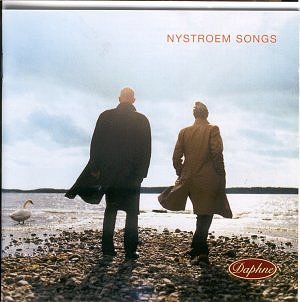 Composer: Gösta Nystroem
Composer: Gösta Nystroem
Works: Songs Sånger vid havet; Hjärtat; Ord mot det tomma; Ur Ångest – Åtta dikter; Bön; Kärlekens visa; Att älska i vårens tid; Gubben och gumman skulle mota vall; Det satt en katt vid Kattegatt; Själ och landskap; Andakt; Nocturne
Performers: Charlotte Hellekant (mezzo-soprano), Ander Kilström (piano)
Recording: Berwaldhallen, 2-3 May; 3 Sept; and Swedish Radio studio 2, 3 Oct, 2001
Label: DAPHNE
Gösta Nystroem, a prominent figure in Swedish music of the early to mid-20th century, emerges in this recording as a composer deeply in touch with both the natural world and the poetic expression of human emotion. His songs, predominantly written between 1914 and 1950, reveal an evolution from late Romanticism into a nuanced personal idiom, steeped in the landscapes and literary traditions of Sweden. This collection, featuring works such as “Sånger vid havet” and “Ur Ångest,” serves as a testament to Nystroem’s intricate approach to song composition, where the interplay between text and music is paramount.
The performances by mezzo-soprano Charlotte Hellekant and pianist Ander Kilström are commendable, marked by a profound sensitivity to the emotional weight of the texts. Hellekant’s voice exhibits a rich, dark timbre that resonates particularly well in the more melancholic songs. Her ability to navigate the recitative-like vocal lines is noteworthy; for instance, in “Jag väntar månen,” her delivery is imbued with a palpable yearning that elevates the lyrical content. Kilström complements her with a nuanced understanding of Nystroem’s harmonic language, accentuating the delicate interplay between voice and piano. The recorded balance captures the subtleties of both performers effectively, allowing Hellekant’s vocal nuances to shine without overpowering Kilström’s sensitive accompaniments.
Nystroem’s engagement with the texts—primarily drawn from Swedish poets like Hjalmar Gullberg and Pär Lagerkvist—reveals a profound respect for their original lyrical intentions. The song cycle “Agony” stands out as a highlight, where the emotional turmoil is mirrored in the music’s harmonic explorations and rhythmic shifts. The piano’s role is not merely supportive; rather, it assumes an active part in the narrative, particularly in the way it reflects and amplifies the somber themes of loss and introspection. The transition to lighter fare in “Det satt en katt vid Kattegatt” provides a refreshing contrast, showcasing Nystroem’s versatility and Hellekant’s skillful adaptability to different moods.
The engineering quality of this recording deserves commendation. The acoustic space of Berwaldhallen is captured beautifully, creating an intimate atmosphere that enhances the listener’s experience. The clarity of sound enables the intricate textures of Nystroem’s harmonies to emerge distinctly, while the resonances of the hall lend a warm richness to the overall presentation. Furthermore, the inclusion of English and German translations alongside the Swedish texts allows for greater accessibility, encouraging a wider audience to engage with Nystroem’s work.
The depth and breadth of Nystroem’s oeuvre, particularly in the realm of art song, find a superb advocate in this recording. For those familiar with Scandinavian song traditions, this collection serves as an essential exploration of a composer whose voice is both unique and representative of his time. Comparisons can be drawn to the works of Britten and Finzi, given their shared affinity for melding text and music in a deeply expressive manner. Hellekant and Kilström’s interpretations highlight the emotional landscape Nystroem navigates, rendering these songs not merely as historical artifacts but as living expressions of the human condition.
This recording stands as a significant contribution to the catalog of Swedish art song, illuminating Nystroem’s artistry and the poignant beauty of his musical language. The performances are imbued with sincerity and technical finesse, making this an essential listen for anyone interested in the evolution of 20th-century song.



